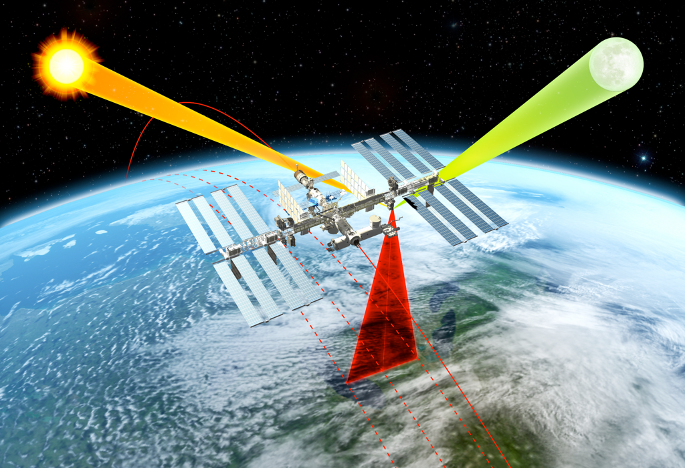Earth Science Missions: International Space Station Instruments
Future Missions

The Climate Absolute Radiance and Refractivity Observatory Pathfinder (CLARREO-PF) will help us better understand Earth’s changing climate by taking measurements of sunlight reflected by Earth and the Moon, anchored to international standards, that will be five-to-ten times more accurate than those from existing sensors. A 3D model of the instrument was rendered at NASA’s Langley Research Center in Hampton, Virginia, which also completed building the power converter in September 2021, and sent the model to the University of Colorado Laboratory for Atmospheric and Space Physics (LASP) for use in its development of the flight instrument. CLARREO-PF will have the unique ability to maintain its high accuracy throughout its lifetime, enabling it to serve as an on-orbit calibration reference for similar instruments and making it possible to detect subtle climate change trends sooner than previously possible. CLARREO-PF is currently scheduled to launch to the space station in NET December 2023 and will take measurements for one year, followed by an additional year of data analysis.
Current Missions
The Global Ecosystem Dynamics Investigation (GEDI) instrument was the first time Earth’s vegetation was measured in both high-resolution and 3D, providing unprecedented views of even the remotest areas. GEDI’s three lasers provide data on surface structure that are valuable for weather forecasting, forest management, glacier and snowpack monitoring, and generating more accurate digital elevation models. Since it launched to the ISS in 2018, GEDI is on track to produce more than 10 billion individual laser shots. NASA’s Scientific Visualization Studio has produced a video of global forest heights using GEDI data. GEDI is led by the University of Maryland, with support from NASA.
Since its launch in 2018, the ECOsystem Spaceborne Thermal Radiometer Experiment on Space Station (ECOSTRESS) has been measuring the temperature of plants from space and monitoring whether those temperatures go up, indicating insufficient water. That data is used to track how changes in vegetation water stress affects the carbon cycle, and are key to the Evaporative Stress Index, a critical drought indicator. ECOSTRESS’ instruments also are useful to detect surface temperature changes, such as wildfires and urban heat islands.
The Orbiting Carbon Observatory-3 (OCO-3) launched to the International Space Station in May 2019. A follow-on to the OCO-2 satellite, literally built with its spare parts, OCO-3 provides data about the distribution of carbon dioxide as it relates to growing urban populations and changing patterns of fossil fuel combustion. OCO-3 explores, for the first time, daily variations in the release and uptake of carbon dioxide by plants and trees in the major tropical rain forests of South America, Africa, and South-East Asia, the largest stores of above-ground carbon on our planet. Measuring the daily variations in these major carbon systems addresses an important missing component in our knowledge and is crucial for explaining global variations in atmospheric carbon dioxide levels.
The Total and Spectral Solar Irradiance Sensor (TSIS-1), which was launched to the International Space Station in 2017, measures the Sun's energy input to Earth. Various satellites have captured a continuous record of this solar energy input since 1978. TSIS-1 sensors advance previous measurements, enabling scientists to study the Sun’s natural influence on Earth’s ozone layer, atmospheric circulation, clouds and ecosystems. These observations are essential for a scientific understanding of the effects of solar variability on the Earth system. Researchers, for example, used TSIS-1 data to analyze how its new data changed the modeled reflection and absorption of solar energy at Earth’s poles. Using the new data, they found significant differences in how much ice and water absorbed and reflected energy.
The Lightning Imaging Sensor (LIS) on the International Space Station detects the distribution and variability of lightning (cloud-to-cloud, intra-cloud, and cloud-to-ground) to advance our understanding of the nature and behavior of lightning and thunderstorms. Two LIS instruments were built in the 1990s. One flew on the Tropical Rainfall Measurement Mission (TRMM) satellite from 1997-2015. The second has been operating on the ISS since 2017 and monitors total global lightning in both day and night. It provides important cross-sensor calibration and validation with the Geostationary Lightning Mapper and with ground-based lightning networks. ISS LIS also supplies near real-time lightning data over data-sparse regions, such as oceans, to support operational weather forecasting and warnings.
The Stratospheric Aerosol and Gas Experiment is a series of instruments that have been making accurate measurements of stratospheric ozone, aerosols, and water vapor in Earth’s atmosphere since 1975. SAGE III is the newest and most advanced addition to the SAGE family and has flown on the International Space Station since 2017, where it takes measurements of gases and aerosols over 70% of the planet using a process called occultation. Every time the sun, or moon, rises and sets – more than 30 times a day on the ISS – SAGE uses the light that passes through the atmosphere to measure gases and particles in that region of the atmosphere. Upon completion of its 3-year mission, SAGE III was renewed for an additional three years.




